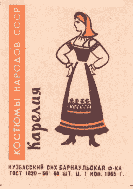
Russian version  |
|
|
The history of Karelian state is long and tragic. Already in the middle of 9-th
century there were known at least two Karelian principalities. And the first
Russian State, according to the legend, was created on the territory of
Karelian principality Rus as a union of Slavic and Karelian tribes.
Labels 5 and 8 are from collection of Victor Raldugin,

1. Karelian women dress

2. Karelian domestic arts

3. Karelian women dress
In the time of blossom of The Great Novgorod Karelian principalities (Southern
- on Karelian Isthmus, and Northern - on Saima Lake) were its semi-independent
vassals.
After devastation of Novgorod by Ivan the III-rd Karelian
principalities almost 200 years stood against Swedish expansion. But the lack
of often promised help from Moscow Russia made the forces uneven and by the
middle of 17-th century Swedes captured most of Karelian lands and Karelian
States were wiped out from the map of Europe.
In the beginning of 18-th century, after Russian reestablish on the Baltic Sea,
Peter the Great hoisted Karelian Flag on the ships of the newly born Russian
Fleet - "To vex the Swedes"

4. Karelian wooden architecture

5. Karelian wooden architecture

6. Karelian wooden architecture
Since that time and till 1920 the name Karelia (Karjala) could only be seen on
the map in the names of provinces of The Great Principality of Finland,
established by Russian tsars as a part of Russian Empire, to which more than
2/3 of Karelian lands were included. And only in 1920 Karelian Labor Commune
was established in Soviet Russia, as a counterbalance to "counterrevolutionary"
Uhta Karelian Republic, proclaimed by Karelian peasants. Since that time the
modern Republic of Karelia counts its age.
The newly created Karelian Labor Commune included not only the lands inhabited
by Karelian, but also Saami, Veps and Russian (Pomor) lands. It was
multi-national since very beginning.

7. VSHV. Pavilion of
Karelian-Finnish SSR, 1954.
Test print (with mistake)

8. 200 years to Onego tractor plant

9. 200 years to Onego tractor plant
The basis of Karelian economy is its huge wood treasures and wood-processing
industry and different mineral deposits - from pure granites to (not yet
approved) diamond pipes.
In the end of 1980-s some Western economists regarded Karelia as the 3-rd
national territory in Soviet Union according to it's independent economic
potential (right after Komi an Yakutia, but ahead of Baltic states). And there
is a hope that by the Republic's 100-th anniversary this potential will start
working.
other labels are from collection of Stanislav Dmitriev
Label 5 presented approximately 1/8 relative to others
| Page top |